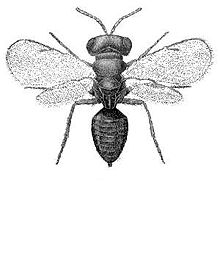- Chalcid wasp
-
Chalcid wasp 
Pteromalus puparum Scientific classification Kingdom: Animalia Phylum: Arthropoda Class: Insecta Order: Hymenoptera Suborder: Apocrita Superfamily: Chalcidoidea Families See text.
Leucospis gigas, family Leucospidae
Chalcid wasps (superfamily Chalcidoidea) belong to the insect order Hymenoptera, and are one of the largest groups within the order, with some 22,000 known species, and an estimated total diversity of anywhere from 60,000 to more than 500,000 species, meaning the vast majority have yet to be discovered and described.
Most of the species are parasitoids of other insects, attacking the egg or larval stage of their host, though many other life cycles are known. These hosts are to be found in at least 12 different insect orders including Lepidoptera (butterflies and moths), Diptera (true flies), Coleoptera (beetles), Hemiptera (true bugs), and other Hymenoptera, as well as two orders of Arachnida, and even one family of nematodes.
A few species are phytophagous and the larvae feed inside seeds, stems, and galls. Generally beneficial to humans as a group, chalcids keep various crop pests under control, and many species have been imported to control insect pests.
They can be found almost everywhere, particularly on flowers, foliage, and in leaf litter, but are often overlooked due to their very small size, which includes the smallest of all known insects (see Dicopomorpha echmepterygis).
Chalcids are tiny, dark-coloured wasps, often metallic blue or green with complex sculpturing on the body. They are also recognized by the characteristic reduced wing venation, similar to that seen in other superfamilies of parasitic wasps. They have a significant part to play in ecosystems and their true importance must not be underestimated.
Taxonomy
Chalcidoidea is a superfamily of Hymenoptera, whose family constituency is in constant flux, as new hypotheses of relationships are constantly being proposed and rejected; with the advent of molecular systematics, it seems that the future will see further revisions of the classification in use today.
There are nineteen extant families recognized at present:
- Agaonidae Walker, 1846
- Aphelinidae Thomson, 1876
- Chalcididae Latreille, 1817
- Encyrtidae Walker, 1837
- Eucharitidae Latreille, 1809
- Eulophidae Westwood, 1829 (including Elasmidae)
- Eupelmidae Walker, 1833
- Eurytomidae Walker, 1832
- Leucospidae Fabricius, 1775
- Mymaridae Haliday, 1833
- Ormyridae Förster, 1856
- Perilampidae Latreille, 1809
- Pteromalidae Dalman, 1820
- Rotoitidae Bouček & Noyes, 1987
- Signiphoridae Ashmead, 1880
- Tanaostigmatidae Howard, 1890
- Tetracampidae Förster, 1856
- Torymidae Walker, 1833
- Trichogrammatidae Haliday, 1851
There is also one extinct family, Khutelchalcididae Rasnitsyn, Basibuyuk & Quicke, 2004.
Of these families, at least five are known to be artificial groups (paraphyletic), and are being - or will be - divided into several families, or perhaps fused with existing families. The most problematic, the Pteromalidae, is, in some classifications, supposed to contain as many as 8 independent lineages, grouped together because of superficial similarities.
Identification
- Key to families Grissell, E. E., and M. E. Schauff. 1990. A handbook of the families of Nearctic Chalcidoidea (Hymenoptera).Entomological Society of Washington (Washington, D.C.) Handbook 1:1-85.Online at [1]
- Gibson, G. A. P., Huber, J. T., and J. B. Woolley. 1997. Annotated keys to the genera of Nearctic Chalcidoidea (Hymenoptera). NRC Research Press.[2]
External links
- Chalcidoidea
- Universal Chalcidoid Database
- Images of chacid wasps on MorphBank, a biological image database
- Pbase Wrongly titled (as Chalcididae) gallery of images..
- Ponent Pictorial overview.
This chalcid wasp-related article is a stub. You can help Wikipedia by expanding it.

